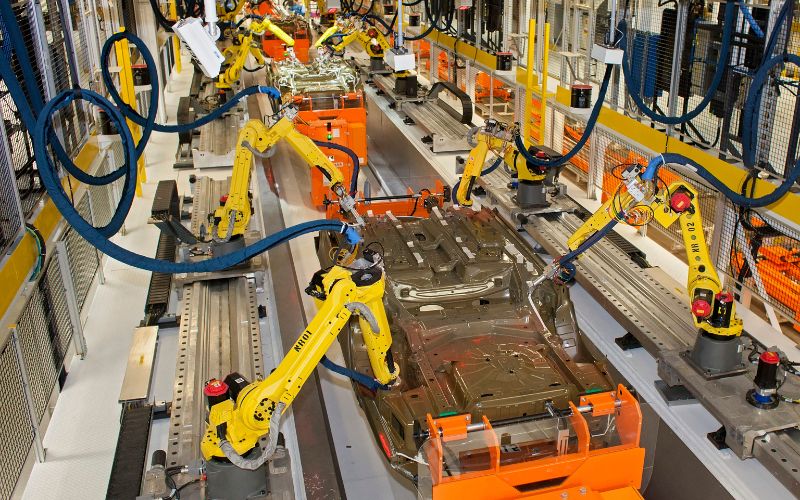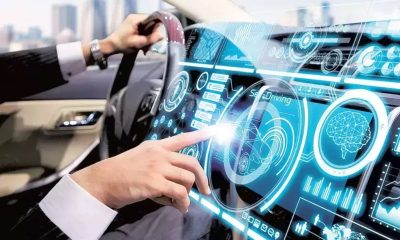Industry Insights
The Future of Electric Vehicles in the Automotive Sector

The automotive sector is undergoing a seismic shift with the emergence and widespread adoption of electric vehicles (EVs). This article delves into the future of electric vehicles, exploring the trends, innovations, and challenges that are reshaping the automotive industry toward a more sustainable and electrified future.
Accelerating Adoption: Surge in Electric Vehicle Sales
Technological Advancements: Pushing the Boundaries of Innovation
Diverse Vehicle Offerings: Beyond Passenger Cars
Charging Infrastructure Expansion: Enabling Long-Distance Travel
As electric vehicles (EVs) surge in popularity, the pivotal concern remains the ability to facilitate long-distance travel seamlessly. This necessity has spurred an intensified focus on the expansion and enhancement of charging infrastructure. The correlation between a robust charging network and the practicality of long-haul journeys for EVs is paramount to the mass adoption and integration of these vehicles into the automotive sector.
The Crucial Role of Infrastructure
The success of EVs beyond local commuting heavily relies on the adequacy and accessibility of charging points along highways and intercity routes. The expansion of charging infrastructure is not just about the sheer number of stations but also their strategic placement. It involves the installation of fast-charging stations, addressing range anxiety, and ensuring compatibility with various EV models.
Collaborative Initiatives and Partnerships
Recognizing the significance of a comprehensive charging network, governments, automotive companies, and private entities are engaging in collaborative efforts. Partnerships between municipalities, charging network providers, and automakers aim to accelerate infrastructure expansion. These initiatives prioritize the installation of charging stations at key points, such as rest areas, fuel stations, and major highways, enabling uninterrupted long-distance travel for EV users.
Technological Advancements in Charging
Advancements in charging technologies play a pivotal role in enabling long-distance travel for EVs. Innovations in rapid charging, battery capabilities, and smart grid integration contribute to reducing charging times and enhancing the overall efficiency of the charging process. Moreover, the standardization of charging connectors and protocols fosters interoperability, ensuring compatibility across diverse EV models and charging stations.
Overcoming Range Anxiety
Addressing range anxiety—the fear of running out of battery power before reaching a charging station—is fundamental in promoting consumer confidence in EVs for long-distance travel. The proliferation of charging points and the development of sophisticated navigation systems that factor in charging station locations and available battery range significantly mitigate this concern.
Future Outlook and Challenges
While significant strides have been made in expanding charging infrastructure, challenges persist. The need for continued investment, regulatory support, and technological innovation remains crucial. Scaling up infrastructure to accommodate the projected growth of EVs and ensuring equitable access to charging facilities in rural and underserved areas pose ongoing challenges that require concerted efforts from stakeholders.
The expansion of charging infrastructure stands as a linchpin in enabling the widespread adoption of electric vehicles for long-distance travel. Its evolution, coupled with technological advancements and collaborative endeavors, holds the promise of transforming EVs into a viable and convenient choice for consumers, reshaping the future landscape of the automotive sector.
Sustainable Materials and Manufacturing: Reducing Environmental Impact
Integration of Autonomous Features: Redefining the Driving Experience
Affordability and Market Accessibility: Overcoming Price Barriers
Environmental Impact and Life-Cycle Assessment: Holistic Sustainability
Conclusion: Electrifying the Road Ahead
In conclusion, the future of electric vehicles in the automotive sector is promising and transformative. With ongoing technological advancements, a growing charging infrastructure, and a commitment to sustainability, electric vehicles are set to play a pivotal role in shaping the future of transportation. As the automotive industry embraces electrification, the road ahead is characterized by cleaner, smarter, and more sustainable mobility.
Industry Insights
Unlocking Potential: How Industrial Robotics & Cobots Staffing Solutions Companies Are Filling Talent Gaps

In today’s rapidly evolving industrial landscape, the integration of robotics and cobots (collaborative robots) has become increasingly prevalent. However, the shortage of skilled professionals in this field poses a significant challenge. This article explores how Industrial Robotics & Cobots Staffing Solutions Companies are addressing this talent gap.
Understanding the Challenge:
The demand for industrial robotics and cobots continues to surge across various sectors, including manufacturing, logistics, healthcare, and more. As automation becomes the norm, businesses are seeking specialized talent to design, program, and maintain these advanced systems. However, finding individuals with the requisite expertise can be challenging. Traditional recruitment methods often fall short when it comes to identifying candidates with the specific skills and experience necessary for roles in robotics and automation.
The Rise of Staffing Solutions Companies:
Industrial Robotics & Cobots Staffing Solutions Companies have emerged as key players in bridging the talent divide. These firms specialize in connecting skilled professionals with organizations seeking to implement robotics and cobot solutions. By leveraging their industry expertise and extensive networks, these companies streamline the recruitment process and facilitate seamless talent acquisition. They understand the unique requirements of roles within the robotics field, allowing them to identify candidates who possess the technical proficiency and adaptability needed to excel in these positions.
Benefits for Employers:
For employers, partnering with Industrial Robotics & Cobots Staffing Solutions Companies offers numerous advantages. These firms possess in-depth knowledge of the robotics landscape and can identify candidates with the precise skills and experience required for specific projects. Moreover, they have access to a diverse pool of talent, including candidates with backgrounds in engineering, programming, mechanics, and more. By tapping into this talent pool, organizations can quickly fill crucial roles and accelerate their automation initiatives. Additionally, by outsourcing the recruitment process to specialized staffing solutions companies, employers can save time and resources while ensuring that they find the best possible candidates for their needs.
Empowering Job Seekers:
Job seekers with expertise in industrial robotics and cobots also benefit from partnering with staffing solutions companies. These firms offer access to a wide range of job opportunities with leading organizations across various industries. Moreover, they provide support throughout the recruitment process, including resume optimization, interview preparation, and career guidance. This support not only helps candidates secure positions that align with their skills and interests but also enables them to advance their careers within the rapidly growing field of robotics and automation. By connecting job seekers with employers who value their expertise, staffing solutions companies play a crucial role in empowering individuals to pursue rewarding careers in robotics.
Closing the Talent Gap:
By facilitating seamless connections between employers and job seekers, Industrial Robotics & Cobots Staffing Solutions Companies play a vital role in closing the talent gap. Their proactive approach to talent acquisition helps organizations overcome recruitment challenges and achieve their automation objectives more efficiently. Moreover, by empowering skilled professionals to pursue rewarding careers in robotics, these firms contribute to the growth and innovation of the industry as a whole. As automation continues to transform industries worldwide, the role of staffing solutions companies in filling talent gaps will become increasingly critical. By bridging the divide between supply and demand for robotics talent, these firms enable organizations to unlock the full potential of automation technologies and drive sustainable growth and competitiveness.
Conclusion:
As the demand for industrial robotics and cobots continues to grow, addressing the talent gap becomes increasingly crucial. Industrial Robotics & Cobots Staffing Solutions Companies serve as valuable partners in this endeavor, connecting skilled professionals with organizations seeking to leverage automation technologies. By fostering collaboration and driving innovation, these firms play a pivotal role in unlocking the full potential of robotics in the modern workforce.
Industry Insights
Driving Success in Manufacturing: The Vital Role of Industrial Robotics & Cobots Job Placement Agencies

In today’s rapidly evolving manufacturing landscape, the integration of cutting-edge technologies like industrial robotics and collaborative robots (cobots) is reshaping production processes. As industries strive for efficiency, quality, and competitiveness, the demand for skilled professionals in robotics and cobot operations is skyrocketing. In this dynamic environment, job placement agencies specializing in industrial robotics and cobots play a pivotal role in driving success for both employers and job seekers.
Meeting Industry Demands Through Specialized Agencies
Industrial robotics & cobots job placement agencies bridge the gap between manufacturing companies seeking qualified talent and skilled individuals aspiring to advance their careers in robotics-related fields. These agencies specialize in identifying, recruiting, and placing candidates with expertise in robot programming, maintenance, operation, and integration. By focusing exclusively on robotics and cobots, these agencies possess deep industry knowledge and extensive networks, enabling them to match the right talent with the right opportunities efficiently. With manufacturing processes becoming increasingly automated, the need for professionals who can operate, maintain, and optimize robotic systems has never been greater. Industrial robotics & cobots job placement agencies understand the specific skill sets and qualifications required in this niche sector, allowing them to source candidates who can hit the ground running and contribute to their employer’s success from day one.
Maximizing Efficiency Through Targeted Recruitment
In the competitive manufacturing landscape, time is of the essence. Industrial robotics & cobots job placement agencies streamline the recruitment process by leveraging their expertise to identify candidates who possess the precise skills and experience required by employers. Through targeted recruitment strategies, these agencies ensure that manufacturing companies can swiftly fill critical positions, minimizing downtime and maximizing operational efficiency. By partnering with industrial robotics & cobots job placement agencies, manufacturing companies can access a pool of pre-screened candidates who have undergone rigorous assessments to verify their technical proficiency, problem-solving abilities, and compatibility with the company culture. This saves valuable time and resources that would otherwise be spent sifting through resumes and conducting interviews, allowing employers to focus on their core business activities while the agency handles the recruitment process.
Navigating Technological Advancements
The field of industrial robotics and cobots is constantly evolving, with new technologies and innovations emerging at a rapid pace. Job placement agencies specializing in this niche are at the forefront of these advancements, staying updated on the latest trends, tools, and methodologies. This knowledge enables them to assess candidates’ proficiency in emerging technologies and match them with forward-thinking companies eager to adopt cutting-edge solutions. As manufacturing processes become increasingly complex and interconnected, the role of industrial robotics & cobots job placement agencies becomes even more crucial. These agencies serve as trusted advisors to both employers and job seekers, providing insights into industry trends, market demands, and skill gaps. By staying ahead of the curve, they ensure that their clients remain competitive in a rapidly changing business environment.
Facilitating Career Growth and Development
For professionals seeking opportunities in the realm of industrial robotics and cobots, job placement agencies offer more than just job placement—they provide pathways for career growth and development. By connecting candidates with companies that offer training, mentorship, and advancement opportunities, these agencies empower individuals to expand their skills, enhance their expertise, and pursue fulfilling careers in the rapidly evolving field of robotics. In addition to matching candidates with job opportunities, industrial robotics & cobots job placement agencies also provide ongoing support and guidance to help individuals navigate their career paths. Whether it’s providing access to professional development resources, offering career counseling services, or facilitating networking opportunities within the industry, these agencies play a vital role in helping candidates achieve their career goals.
Conclusion: The Vital Role of Industrial Robotics & Cobots Job Placement Agencies
In conclusion, industrial robotics & cobots job placement agencies serve as invaluable partners in the manufacturing sector’s quest for success. By aligning talent with opportunity, these agencies drive efficiency, innovation, and growth, enabling manufacturing companies to stay ahead in today’s competitive landscape. As technology continues to transform the industry, the role of specialized job placement agencies becomes increasingly vital, ensuring that the right skills are matched with the right opportunities, propelling the manufacturing sector towards a future of continued advancement and prosperity.
Industry Insights
Navigating Career Transitions: Insights from Workforce Development & Training Career Consultants

In the realm of professional life, change is inevitable. Whether prompted by personal growth, industry shifts, or unforeseen circumstances, career transitions are a common reality for many individuals. However, navigating these transitions can often feel like embarking on a journey without a map. This is where the expertise of Workforce Development & Training Career Consultants becomes invaluable. With their guidance and insights, individuals can traverse the terrain of career transitions with confidence and clarity.
Understanding Career Transitions:
Transitioning from one career to another is a multifaceted process that requires careful planning and introspection. It begins with a thorough self-assessment, where individuals evaluate their skills, interests, and values to determine their career aspirations. This introspective phase sets the foundation for the transition journey, guiding individuals towards roles and industries that align with their personal and professional goals.
The Role of Workforce Development & Training Career Consultants:
At the heart of successful career transitions are Workforce Development & Training Career Consultants. These professionals specialize in guiding individuals through every step of the transition process. Through one-on-one consultations, they offer personalized guidance tailored to the unique needs and goals of each client. Whether it’s identifying transferable skills, exploring new industries, or developing strategies for success, these consultants provide invaluable support and expertise.
Navigating Uncertainty with Expertise:
In today’s rapidly evolving job market, uncertainty is a constant companion. Economic downturns, technological advancements, and industry disruptions can create waves of uncertainty, leaving individuals feeling adrift in their career paths. This is where Workforce Development & Training Career Consultants shine. Armed with a deep understanding of market trends and industry insights, they provide clients with the tools and resources needed to navigate uncertainty with confidence. From resume optimization to interview preparation, these consultants offer practical solutions to help individuals stand out in a competitive job market.
Tailored Training and Development:
One of the key offerings of Workforce Development & Training Career Consultants is their ability to provide tailored training and development programs. These programs are designed to equip individuals with the skills and knowledge necessary to succeed in their desired fields. Whether it’s mastering new technologies, honing leadership skills, or gaining industry-specific certifications, these training programs empower individuals to stay ahead of the curve and position themselves for success.
Maximizing Opportunities:
With the guidance of Workforce Development & Training Career Consultants, individuals can maximize opportunities for career advancement and professional growth. By leveraging their expertise, clients gain access to a wealth of resources, including networking opportunities, job leads, and industry connections. Armed with this support system, individuals can navigate the complexities of the job market with confidence, knowing that they have a team of experts in their corner.
Overcoming Challenges:
While career transitions offer opportunities for growth and advancement, they are not without their challenges. Whether it’s overcoming self-doubt, navigating logistical hurdles, or adjusting to a new work culture, individuals may encounter obstacles along the way. However, with the guidance of experienced consultants, these challenges can be transformed into opportunities for personal and professional development. Through targeted coaching and support, consultants help clients develop the resilience and adaptability needed to thrive in any environment.
Building Resilience and Adaptability:
At the core of successful career transitions lies resilience and adaptability. Workforce Development & Training Career Consultants understand the importance of these qualities and work tirelessly to instill them in their clients. Through workshops, seminars, and coaching sessions, individuals learn how to embrace change, overcome setbacks, and navigate uncertainty with grace and resilience. Armed with these skills, they emerge from the transition process stronger, more confident, and better equipped to face whatever challenges lie ahead.
Conclusion:
In conclusion, navigating career transitions is a complex and challenging process, but with the guidance of Workforce Development & Training Career Consultants, individuals can embark on this journey with confidence and clarity. From self-assessment to skill development, these consultants offer the expertise, support, and resources needed to navigate every step of the transition process. By leveraging their insights and guidance, individuals can position themselves for success in a rapidly evolving job market, ensuring a smooth and rewarding transition to the next phase of their career
-

 Industry Insights7 months ago
Industry Insights7 months agoTech Trends Shaping the Future: A Comprehensive Overview
-

 Career Exploration7 months ago
Career Exploration7 months agoSpace Tourism: Opportunities Beyond the Stratosphere
-

 Professional Development7 months ago
Professional Development7 months agoThe Art of Effective Time Management for Career Growth
-

 Job Search Strategies7 months ago
Job Search Strategies7 months agoEffective Time Management During Job Hunting
-

 Job Search Strategies7 months ago
Job Search Strategies7 months agoUsing Job Search Engines to Your Advantage
-

 Job Search Strategies7 months ago
Job Search Strategies7 months agoRefining Your Elevator Pitch for Networking Success
-

 Industry Insights7 months ago
Industry Insights7 months agoValue-Based Care: Reshaping Healthcare Industry Models
-

 Job Search Strategies7 months ago
Job Search Strategies7 months agoExcel in the Art of Navigating Job Fairs and Networking Events

























